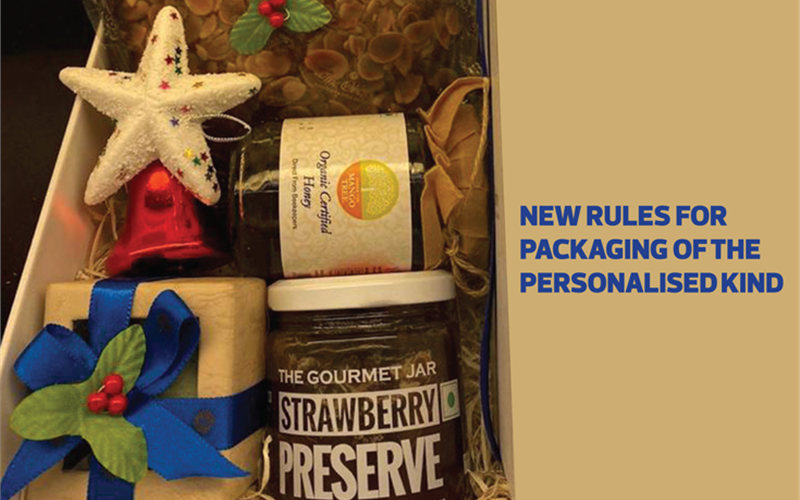New rules for packaging of the personalised kind
One of the niche print markets hit hard during the pandemic was the luxury hospitality segment. So much so that ‘the new normal’ has already made some printed products used in the sector redundant. At the same time, it has opened doors for new product verticals. Arjun Dewan, partner at Nandini Aakarshita, a Gurgaon-based startup, which offers print services to luxury hotels, gives the lowdown
11 Jun 2021 | By WhatPackaging? Team
What’s happening in the hospitality sector?
We are in the luxury hospitality segment, which accounts for an important part of the Indian hotel industry, growing at a CAGR of 11% per annum. We were growing our customer base, getting work from companies such as East India Hotels, Indian Hotels, Aria Hotels, Vatika Hospitality, Old World Hospitality, Untitled Hotels PVR, and Big Fish Ventures, among others.
Things began to change in the last week of February 2020, when travel restrictions started. A food festival involving two Michelin star winner, Chef Christoph Rainer, got cancelled because the host correctly guessed that things were going to get worse. From our perspective, it meant no printed menus, no printed announcements, no printed memorabilia, and no printed in-room messages. And from there till now it’s exactly a year. We are still standing, however, with reduced cash, business and a longer repayment cycle.
From a printer’s perspective, what has changed in the hospitality industry?
Traditional hospitality companies have been great supporters of print. A leading luxury hotel could order over 260 printed items every month as part of its print inventory. The products would straddle different price points and printing techniques.

Hotels experienced more than expected revenues from gift hamper sales
A business card for instance would be on very expensive Neenah cardstock involving three to four different print applications. A contractual staff card, on the other hand, would be on the cheapest pulp board and would involve just a single-colour mini-offset press. All this stopped, and I believe some of the regular printed items will no longer be ordered even when things normalise. It’s not just about reduced rates and cutting costs. Technology has also played a role in making some of the printed products redundant.
Seen another way, when a USD 20-billion industry shrinks by 50%, it will definitely impact all those who serve the industry.
Is it all gloom and doom?
Surprisingly, the current situation has opened some new doors. However, the opportunities offered by the new demands were not enough to replace the loss that resulted from the closure of the traditional market, but it did compensate to some extent. In addition, it allowed us to add new products to our portfolio.
For example, restaurants saw zero dine-in business, and hotels started delivering food. Elaborate meals were attractively packaged and delivered. That meant a demand for printed products such as packaging boxes, cutlery pouches, paper bags, labels, advertisement material, among others. All hotels got printed material related to social distance, hygiene, mask usage and contactless payment. So, if a hotel earlier ordered 25 menu cards for a speciality restaurant, it now moved to a digital menu. However, it used printed single-use placemats from which the guest could scan the menu.

Luxury gifting and food deliveries were big beneficiaries amid the lockdown
One surprisingly big upside came during the festive season, where leading hotels saw more than expected revenues from their sale of gift hampers. I thought people would have spent less on luxury gifting. In hindsight, however, it made perfect sense – people had been cut off from their loved ones and sending a physical gift during the season was a nice way to stay connected. Luxury hotels are known for high quality and hygiene. Therefore, spending for a gift from here was justified.
Have you seen any other interesting trend?
Companies that were agile and in control of their production capitalised on the new opportunities that emerged. For example, digital printers saw a huge demand in printing labels and stickers. Die-cutting machines were used to shape face shields; opportunities emerged for single-use surgical masks.
They used the same workforce, which was earlier involved in print fabrication. Artisans, who earlier made leather menu covers, got the chance to make attractive sanitiser holders. This trend was not restricted just to the print business. We also saw great entrepreneurial spirit from employees who lost their jobs. Housekeeping staff began home and office sanitisation businesses, chefs started home delivery of gourmet meals and technology staff started offering their services to those who were working from home.

Traditional hospitality companies have been great supporters of print
What’s your forecast for the immediate future?
At the end of the first wave, I foresaw opportunities in packaging driven by the emotional urge of individuals and companies to stay connected in the midst of social isolation. Luxury gifting and food deliveries were the big beneficiaries of the trend. The second wave, or as WHO says, the Delta variant, has hit us harder at home and I believe the trend of gifting and food deliveries will not be big this time around.
Luxury hospitality is very vulnerable today. If the last time, people spent on emotional wellbeing and self-indulgent consumption, this time, I foresee people spending more on education and mental development. Books, both educational and recreational could be the winners. As vaccination picks up in India, children will emerge as the largest unprotected segment.
I foresee parents spending more on the mental and emotional development of their children in the face of continued homeschooling and isolation. Internationally, markets in the US and Europe are getting back to normal after vaccination. One should witness consumption in those countries rising – meaning more printing related to sectors like garments and gifting.












 See All
See All